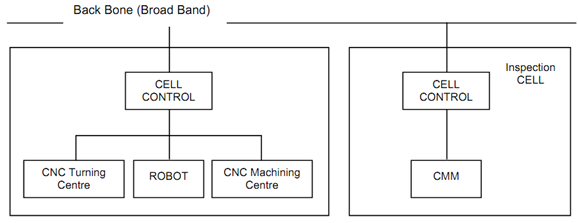Bus Network
The other types of networks offer distributed control, so the risk of total network failure is reduced. The bus network is the most commonly used networking system mainly because of the success of the Ethernet developed by Xerox in the early 1970s. A bus network looks like a branch of a tree with the computing equipment attached like leaves to the twigs (Figure 6). Each of the equipment has its own unique address by which the information flowing in the bus is picked up. Thus, any equipment (e.g., computing terminal, normally called a node) can send data at any moment to any address. However, if the bus is occupied by the data being sent (collisions occurring between two packets of data), the information will be notified and the equipment has to resend the data. The data transmission in this type of network is one of the highest speeds available, up to 10 Mbits per second. This is the most common form of network used in manufacturing applications.

Figure 6 : Bus Network